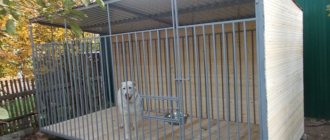The structure of the limbs of dogs
The structure of the front and hind limbs of dogs has a large anatomical difference. Since the front legs support the chest, they bear the bulk of the animal’s weight. Knowledge of the pet's anatomy by its owner is a guarantee that the initial diagnosis and first aid, if a fracture of the dog's front paw or hind limb bone occurs, will be correct.
Structure of the thoracic (fore) limb:
- The shoulder blade is set obliquely, turning into the humerus.
- Shoulder.
- The forearm is where the radius and ulna bones meet at the joint.
- The wrist, consisting of 7 asymmetrical bones, is connected to the bones of the metacarpus.
- Metacarpus consisting of five fingers, four of which have three phalanges, and one only two. The fingers are equipped with claws made of hard keratinized tissue, which, unlike cat claws, cannot be retracted.
The structure of the pelvic (hind) limbs:
- thigh, consisting of the femur attached by a joint to the pelvic bone;
- knee;
- tibia, consisting of the tibia and fibula;
- hock or tarsal joint;
- the metatarsus, which together with the toes makes up the foot.
The hind legs are much stronger than the front legs, since they are responsible for the kick that the animal needs to make a jump or jerk. As a rule, a fracture of a dog's hind leg in most cases is the result of an injury from a collision with a vehicle, a jump or a fall from a height.
Treatment of paw fractures
First, the doctor will provide high-quality anesthesia; without this, the dog will not allow itself to be examined. Next, the limb and pet are examined, an x-ray of the broken paw is prescribed, as well as an ultrasound, x-ray , and other studies if damage to internal organs is suspected. For example, when falling from a great height or being hit by a car, a broken paw in a puppy is almost always combined with an injury to the abdominal cavity or chest.
Need for surgery
When a dog's paw is broken, it is almost impossible to get by with a plaster cast , so in 99% of cases surgery is necessary. Surgery is indicated for several reasons:
- It is almost impossible to force a dog to take care of the leg and the cast. A fracture of the hind leg may still allow this, but not always. Pets try to remove the cast as soon as possible, even if they fail, they can still cause additional injury to themselves.
- Since pets never break their legs through negligence, they are more often open, multiple with various complications. Therefore, an operation is needed to connect all the fragments and sew up the damaged tissue.
- Research has proven that bones heal most quickly and efficiently with careful comparison of fragments and their reliable fixation; early support on the limb has a positive effect. All this is possible only with surgery.
Types of operation
The fusion of bones is called osteosynthesis. There are several types of surgery:
- Elezarov's apparatus . The fragments are fixed using knitting needles on metal rings. This method is applicable for large and medium breeds. The ring is not removable and securely fixes the bones.
- The Kishner apparatus is a structure made of self-tapping rods attached to a metal stay. It is usually used for intra-articular fractures and when it is not possible to install the Elizarov apparatus. Recently, special thinner self-tapping needles and plastic rods have been used, but the basic principle of the Kishner apparatus remains unchanged.
- Internal fixation is used when it is impossible to install any of the devices. In this case, the pins are inserted inside the tubular bone. Later they are not removed, but are left for life. This type of operation is the most complex, and not every surgeon is capable of performing it efficiently.
The doctor decides which type of operation to choose and what to do. The choice depends on the type and characteristics of the fracture, as well as on the experience and preferences of the veterinarian.
Types of fractures
Most limb fractures have obvious signs and are detected by the animal owner in the first minutes after the incident. As a rule, the dog does not step on the paw, tries to protect it, and does not allow it to be touched.
In veterinary medicine, the following types of damage to the integrity of the bones of the limbs are distinguished:
- A fissure is the mildest form of a fracture; it can be asymptomatic or with minor disturbances when the animal moves: slight lameness, caution when walking. As a rule, it is only detected during an x-ray examination if the dog owner witnessed the incident and has reason to believe that the animal was injured.
- Impaction fractures often occur in large breed dogs or puppies. The clinical picture is unclear, since the injured bones fix each other.
- A closed fracture without displacement - the damaged bone does not change its anatomical position. The animal experiences severe pain, the limb is practically devoid of movement.
- A closed fracture with displacement is one of the severe types of fractures, complicated by the fact that the damaged bone is displaced and can damage large vessels or internal organs of the animal. The injury is accompanied by severe pain and complete impairment of motor function.
- Open is the most complex injury, which is characterized by damage not only to the bone, but also to nearby internal and external tissues, blood vessels, tendons and ligaments. Quite often when a vehicle collides, the end result of such an incident is a fracture of the dog’s hip bone.
- Complex intra-articular pathology - the diagnosis is made in cases where a violation of the integrity of bone tissue reaches a nearby joint.
The most severe fracture in terms of the location of the injury is considered to be a fracture of the dog’s pelvis; in this case, the animal requires long-term treatment and rehabilitation.
Fracture surgery
As already mentioned, surgery for a broken paw in a dog is the main and most correct treatment option. Such operations are performed only under high-quality general anesthesia, exclusively by professional and experienced surgeons using appropriate consumables and structures. In terms of its duration, osteosynthesis is a complex operation that takes a lot of time. Naturally, everything depends on the damage itself and the doctor’s pre-planned behavior strategy. Based on the data obtained about the animal and the results of x-ray examinations, the doctor draws up a plan for the future operation and selects those materials that are suitable for a particular animal in a given situation.
The cost of surgery for a broken paw in a dog is determined depending on the complexity of the operation itself, the amount of material required and additional preoperative and postoperative hospital care and examination.
Symptoms of a fracture in a dog
The owner will be able to detect an injury in his pet even if he has approximate knowledge of how the dog behaves when its paw is broken. Common clinical manifestations for this type of injury are pain, lameness, and traumatic swelling of the injured paw. Knowing the symptoms will help you determine if your dog has a paw bruise or fracture.
The main characteristic signs that allow us to understand the nature of this type of injury:
- With an open fracture, traumatic damage to the skin and muscles is observed; an area of damaged bone and bleeding may be visible.
- In a displaced fracture, there is a noticeable shift in the anatomical position of the bone, asymmetry in relation to the healthy paw.
- If you receive a minor injury in the form of a crack or an incomplete linear fracture, swelling may appear in the injured area after 2–3 days.
- With most types of fractures, the animal loses the ability to rely on the damaged limb, and swelling appears.
- Palpation of the damaged area causes a strong negative reaction from the animal, which indicates severe pain.
- A fracture of a toe of the front or hind limb also brings significant pain and a decrease in the animal’s motor activity.
When dogs have fractures, there is a fever; such injuries are also accompanied by tachycardia, rapid breathing, decreased appetite and a general depressed state.
Methods for diagnosing a broken paw in a dog and treatment
In order to accurately determine the type of fracture and possible complications
that occur with certain types of bone injuries, primarily use radiography. The photographs will clearly show the bones and their position relative to each other and neighboring areas. Also, the diagnosis can be established after the animal is thoroughly examined by a veterinarian. With this type of injury, no tests need to be taken, but only visual diagnostic methods are used.
However, if some time has passed since the injury and an infection has entered the wound, then we are talking about a secondary wound infection and in this case the veterinarian may already prescribe tests. In doing so, he will assign:
- General laboratory blood test.
- General laboratory urine analysis.
- A smear-imprint from the surface of the wound for subsequent microscopy.
When the studies are completed, the doctor will prescribe adequate treatment for the secondary wound infection in conjunction with treatment for the bone fracture.
Treatment in a situation where a dog has a broken paw
What is the treatment for such severe limb injuries in a dog? The most important thing is to ensure immobility of the injured limb to prevent secondary injuries.
- If your dog has a broken paw, you need to:
- Apply an immobilizing bandage. To do this, plaster bandages are used to subsequently ensure the immobility of the damaged paw. Such actions are performed with a closed type of fracture or with a bone crack.
- With an open fracture, everything is more complicated. The open wound should be washed with furatsilin or an aqueous solution of chlorhexidine. Introduce an antibiotic into the wound to suppress the development of pathogenic flora.
For any type of fracture, take the injured animal to the YA-VET Center for Emergency Veterinary Care for Animals, and if this is impossible, you must urgently call a veterinarian at home by phone.
Self-help for an animal when a dog’s paw breaks
Self-help for an animal with an open fracture involves applying a plaster cast after treating the wound. All manipulations must be carried out with pain relief, since the dog may even experience severe pain and/or traumatic shock. For pain relief, a conductive novocaine blockade is used using a sterile solution of Novocaine, Procaine, Ultracaine or some other anesthetic.
In case of open damage, the bones are placed in a physiological position and then a sterile bandage is first applied in 1-2 layers, and then only a splint can be applied from available hard materials and a plaster cast on top. The most important thing in such a bandage is reliable fixation of the fracture site and prevention of secondary damage.
The most difficult case of the described injury is a displaced fracture . With this type of damage, it will not be possible to manage on your own, since osteosynthesis surgery will be required. When performing this type of surgical intervention, the veterinarian installs a metal pin (it is made of surgical steel) into the canal of the damaged bone and fixes the bone fragments relative to this pin. Of course, such surgery is performed under general anesthesia of the dog.
After this operation to restore the integrity of the limb, a mandatory bandage using a fixative material is required. Such a remedy can be a splint - a special plaster cast that fixes the entire limb or only its damaged area.
How to provide first aid to a pet?
Having detected signs of injury, the owner must provide first aid to the animal. Securely fix the fracture and the damaged limb itself so that the pet cannot cause itself further harm from fear or pain. It is also important to calm the animal and limit the possibility of movement as much as possible.
Sequence of actions for open damage:
- Stop the bleeding.
- Clean the wound from dirt and foreign bodies.
- Treat with an antiseptic.
In case of arterial bleeding, it is necessary to apply a tourniquet using available means: leash, collar, scarf.
To avoid infection, a bandage is applied to the damaged area and the dog is provided with maximum rest until the doctor arrives or arrives at the veterinary clinic.
If the dog is large and cannot be carried in your arms, you can help it get up and start moving by passing a towel, leash, or blanket under the chest, thereby supporting the animal.
First aid
If an injury is detected in a pet, the owner should immediately contact a veterinary clinic for specialized help. The sooner you do this, the better.
A competent sequence of actions at home is very important so as not to harm the animal. With an open fracture, the first priority is to stop the bleeding. To do this, apply a tourniquet from available materials above the wound site and tighten it tightly. Next, the wound surface should be cleaned of splinters and contaminants and treated with an antiseptic solution (hydrogen peroxide, miramistin). Alcohol and alcohol-containing preparations cannot be used. The next step is to apply a bandage to the wound in order to avoid infection.
It is strictly prohibited to reset bone fragments on your own! This is very painful and there is a high risk of vascular rupture. The dog needs complete rest and immobilization of the limb. The paw is fixed to a handy device (plywood, wooden board, thick cardboard) using a scarf or belt. When transporting your pet to the clinic, it should be placed in the back seat of the car. If it is a miniature breed, then a box or carrier will do. As a last resort, it is allowed to hold the animal in your arms.
Further treatment
Treatment of fractures in dogs is a task that requires maximum patience and composure from the owner.
Only a doctor should make appointments, apply plaster and plan other procedures. Self-treatment at home can lead to improper healing of damaged bones or even greater complications.
At the veterinary hospital, during the initial examination, all necessary diagnostic procedures will be carried out and a treatment strategy will be developed. If there is an open fracture, surgery will be required. If necessary, a pin or plates are installed, and only then will plaster or splints be applied.
The most severe is a fracture of the pelvis in a dog; whether it will often walk depends on the complexity of the injury and the timeliness of the assistance provided. Often such an injury is accompanied by damage to internal organs, which significantly aggravates the picture. However, immediate and qualified surgical intervention allows the consequences to be minimized as much as possible and leads to the animal’s recovery.
The cost of the operation is largely determined by the nature of the intervention.
The role of the dog owner in such situations:
- timely delivery of the victim to a veterinarian;
- ensuring appropriate follow-up care;
- strict adherence to all specialist recommendations.
In the first time after applying fixatives, it may be necessary to take analgesics, but this should not be uncontrolled. The dosage and frequency should be prescribed by a veterinarian.
A callus in a dog after a fracture forms on average in 1–2.5 months. It is this time that the bones heal during an uncomplicated fracture. Although its exact duration depends on the individual characteristics of the animal: its physique, age, state of health, as well as on how the dog behaves when a paw is broken. Excessive activity of the animal can provoke re-injury of the injured limb.
Another important factor influencing the duration of healing is the care provided to the animal.
Rehabilitation measures and prevention, broken paw in a dog
With proper assistance to an animal when a dog’s paw is broken, the bones will heal quickly and correctly. Both the owner and the pet will soon be completely fine and play and frolic again. But in order for your dog to recover faster, you need, firstly, to provide her with peace and not overload her with any stress.
.
The animal's food should be easily digestible and contain large amounts of calcium. It is this natural mineral that is involved in the processes of bone growth and the formation of bone tissue. You can add powdered tablets of calcium gluconate or calcium glycerophosphate to the food. These drugs reliably replenish calcium reserves in the body, which promotes rapid healing of injuries.
Walking the dog in sunny weather will also promote rapid bone healing, because it is known that sunlight promotes the production of provitamin D3 in the body of warm-blooded animals, and this, in turn, directly contributes to the strength of the skeletal system. For the same purposes, it is possible to use an oil solution of ergocalciferol (vitamin D3), which is sold in pharmacies.
Prevention is that the domestic dog should not be left outside without the supervision of the owner. You should not allow your pet to run through abandoned areas with large accumulations of garbage, tree branches and various industrial wastes. In such cases, the risk of damage to the dog’s paws, including the risk of a fracture, increases many times over.
How to care for a dog with a cast?
The application of a cast often leads to the fact that within a few days the pet begins to feel much better and show its former activity.
During this period, it is important to try to minimize her physical activity. If, from a certain day, the veterinarian has allowed walking, then they must be exclusively on a leash in a quiet place away from crowds of people, dogs and other objects that can provoke the activity of a sick animal.
In all other cases, the maximum activity is daily exercise. For small dogs during this period, it is more advisable to purchase a tray and arrange a toilet following the example of a cat.
Possible errors and omissions during this period:
- resumption of animal activity;
- damage to the plaster cast;
- independent release of the animal from the cast.
If the cast or splint gets wet, you need to inform your veterinarian; most likely, he will decide to replace the wet fixation.
Any damage to the fixing means must be prevented, and if the plaster or splint is damaged, immediately take it to a veterinary hospital.
The length of the subsequent recovery period largely depends on how long the fracture takes to heal.
First signs
When a dog's finger is broken, owners can immediately notice a change in the animal's behavior . Fractures are always accompanied by severe pain, the animal begins to whine, limp, and take care of the damaged paw. The dog can walk on the injured paw, but will not be able to put all the weight on it.
As with any fracture, swelling and severe pain appear at the site of injury. If you carefully palpate the fracture site, you will notice a thickening of the finger relative to the others, pain, and increased temperature in this place.
Rehabilitation of a pet after a fracture
The basis of the rehabilitation process is a gradual increase in physical activity, which will be feasible and will not lead to a worsening of the condition of the damaged paw.
Going down stairs is especially dangerous for dogs during the recovery period, so if such a need arises and the size of the pet allows it, then it is better to take the animal down for a walk in your arms. Climbing flights of stairs is much easier for dogs than going downhill.
During the period of treatment and subsequent rehabilitation, animals are prescribed special medications designed to speed up recovery:
- calcium, magnesium preparations;
- vitamins D3, B6 and B12;
- biological and mineral supplements containing biotin, collagen, folic acid.
In the case of intra-articular pathology resulting from a limb injury, at the stage of treatment and rehabilitation, to restore the articular cartilage and protect it from possible damage in the future, the animal should be given chondroprotectors.
To facilitate rehabilitation, kinesiology tape is used to stabilize the joint, prevent re-injury and reduce pain.
To speed up tissue restoration processes, irradiation with infrared lamps is used; such devices are available in modern veterinary clinics.
Being in the fresh air and sunbathing is of great importance. Thanks to the sun, the body synthesizes vitamin D, which is necessary for the restoration of bone tissue.
What to do for a broken toe in dogs
The owners' first actions should be aimed at reducing swelling . To do this, you need to apply cold to the injury site. This must be done carefully, because animals, unlike humans, will not sit quietly if it causes them pain. Therefore, it is better to carefully place the dog's paw on the cooled object or coolant.
Relieving pain at home is somewhat more difficult. Firstly, not all drugs in the “human” first aid kit are suitable for animals. Secondly, you need to know the dosage. And thirdly, painkillers in the form of injections are the most effective. But not every owner can give a dog an injection. But, nevertheless, if it is not possible to immediately deliver the animal to a specialist, you can give ¼ - 1 tablet of analgin.
If the fracture is open, associated with bites, then there will be an open wound with profuse bleeding. In this case, a tight bandage should be applied . It does not have to be professional; the main task is to stop the bleeding and fix possible debris together. In the future, the doctor will be able to figure out what’s what and provide the necessary assistance. But in this case, contacting a specialist should be as urgent as possible.
What should a dog's diet be like during an injury?
The correct diet during the period of forced reduction in the animal’s activity should have lower caloric content than in the period before the injury.
If the owner takes this circumstance into account and continues to feed the full diet during a fracture, the animal may gain excess weight, which will increase the load on the limbs and negatively affect rehabilitation, and can subsequently lead to obesity.
One option for a responsible approach to feeding a sick dog would be to purchase special ready-made food designed for such cases. In this case, it is important to follow the manufacturer's instructions located on the packaging of the finished food.
Basic rules of diet during the recovery period:
- Reducing daily caloric intake.
- Introduction to the menu of foods or feeds enriched with vitamin D, calcium, copper, manganese and magnesium.
It is better to discuss special nutrition with a veterinarian, who can take into account both the sufficient supply of vital substances and nutritional value.
Video: limb fractures in dogs, their symptoms and treatment
Main causes of toe fractures in dogs
Most often, a broken finger in a dog, as a separate, independent injury, occurs due to the fault of the owner . Usually this is the fall of a heavy object on the paw, blows or pinching of the paws by the door, and often owners can accidentally step on their pet’s paw. Small breed dogs, such as Yorkshire terriers, toy terriers, and Pekingese, especially suffer from this.
Sometimes dogs themselves can perform actions that lead to a broken toe. Such injuries are typical for large breed dogs at a young age. During active play in nature, part of the animal's paw may fall into a hole or be caught between the roots. In this case, heavy weight and strong inertia can twist the animal’s finger, which will lead to its fracture.
Another common cause of toe fractures in dogs, regardless of size and breed, is bites . During play or fighting, dogs can bite each other's paws, which can be accompanied by broken toes.
First aid
The main goals of treatment are to reduce pain (to reduce the dog's fracture symptoms), reduce the risk of additional accidents, and prevent open wounds from becoming infected. In all cases there are three basic rules:
- Do not attempt to repair the fracture;
- Do not use antiseptics or ointments on open fractures;
- Take your dog to the vet immediately.
Below are instructions for your first aid steps for specific types of bone fractures in dogs.










